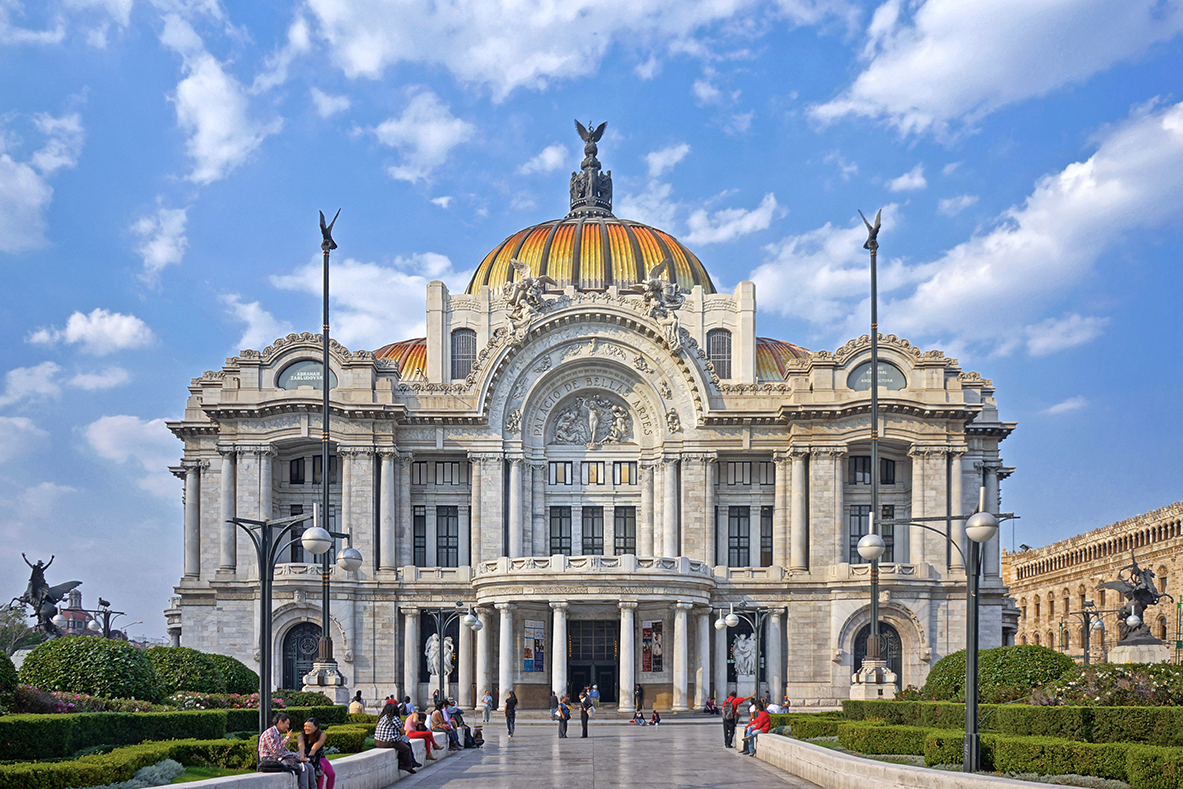Further to my previous post. Today that my memories about the premiere of the vocal-symphonic opus [1] are still fresh, I’ll be working for the relevant section of my book ¿Me Ayudarás?
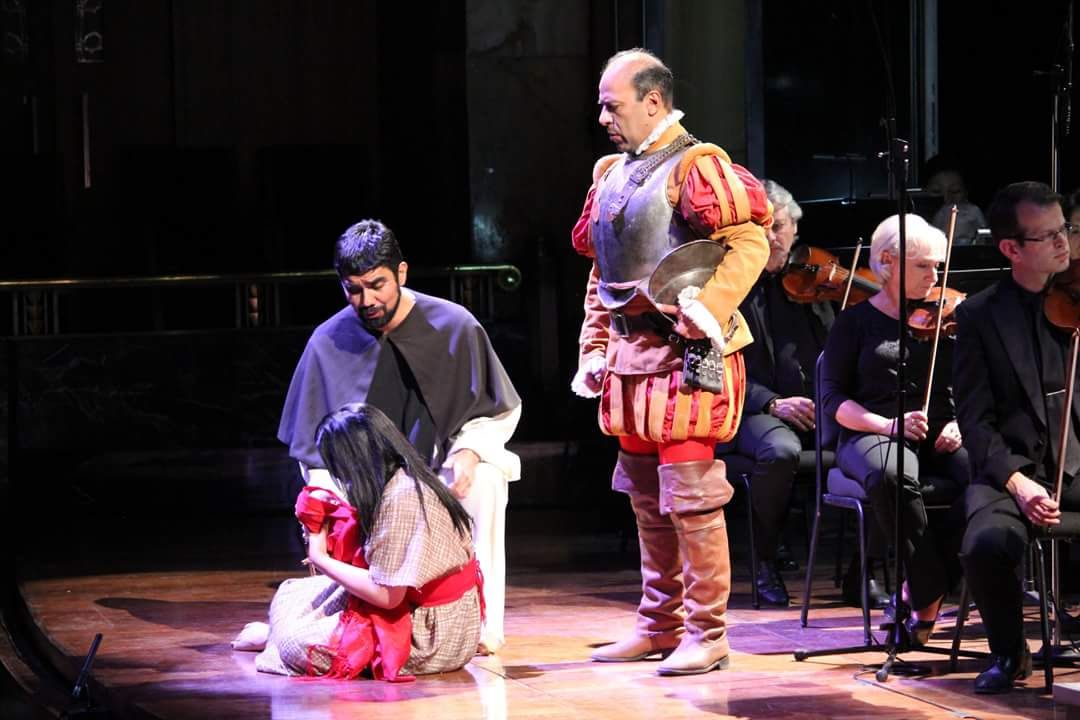
If I finish tonight, tomorrow I will be able to resume the Kriminalgeschichte series.
________________
[1] La Santa Furia is a hybrid genre between oratorio, opera, and cantata. In addition to the common section of strings, it includes woodwind instruments, six horns, three trumpets, four trombones and tuba, two harps, piano and timpani, other percussion instruments as well as a quartet vocal soloist, a sextet of men, and a mixed choir with four voices (115 choir singers in total): more than 200 artists on stage.
Month: February 2018
Finally, La Santa Furia, the oratorio-opera of my late father, was premiered this Friday, and also today, at the Palacio de Bellas Artes.
La Santa Furia is a tribute to the Dominican Friar Bartolomé de Las Casas. One of the main prelates of the order of the Dominicans crossed the Atlantic, from Rome, to attend the premiere.
After today’s event, at the private banquet with over fifty select guests, I sat at a table with four Catholic priests who attended the opera. Never in my life had I shared the table with so many priests.
About La Santa Furia I have already written a bit on this blog (see e.g.: here) and will expand my criticism in a book. For the moment I would just like to respond to an email that came to me today from a most traditional Christian:
Cesar,
On your blog, you fantasise about burning all Churches to the ground. Did you ever hear Émile Zola’s quote on the issue? ‘Civilisation will not attain to its perfection until the last stone from the last church falls on the last priest’.
Of course, I, as a pre-Conciliar Roman Catholic, disagree with you, here. Do we really want to burn down Saint Peter’s—designed by Freemasons Bernini and Michelangelo? Its Egyptian Obelisk? Domed Roof? Do we really want to burn down Pisa Cathedral and other sublime architectural triumphs?
The Notre Dame in Paris was built by Templars. It has the twin towers, of Joachim and Boaz, representing the balance of hatred and love; black and white. Again, this is architecture that contradicts the ‘love your enemies’ slave morality of the Gospels.
A ‘bonfire of the vanities’ would be welcomed by Biblicists and puritans. The Bible—promoting mediocrity in everything—wants you to pray in your closet/inner room. It’s funny that in the KJV, Jesus Christ tells you to go into the closet! The KJV was translated by homosexuals.
I follow the fundamentalist protestants quite closely, and a lot of them only believe in house churches: worshipping Adonai and Messiah at home. Burning a lot of these crypto-Masonic and crypto-druidic edifices would be to play into their hands.
I agree with you: everything derived from Judaism, in Catholicism, needs to be ruthlessly expunged. In the Marcionite version of the myth of Our Lord and Savior, Jesus Christ, He shows up, miraculously; in Palestine, condemns Jews, calls for their extermination, and then ascends to Heaven. Crucifixion optional.
Unfortunately, the cause of Marcion did not prevail within the Catholic Church.
C.
Playing into the hands of the Protestants? Hardly: In my little Utopia no Protestant would remain alive.
As to the buildings, even before receiving this letter I had thought about the subject. I would respect the cathedrals, although I would order not to repair them throughout the millenary Reich. With time they would collapse by themselves, in an era when there is no longer any Christian on the face of the Earth.
In the case of St. Peter’s Basilica things are very different. The third article of Nietzsche’s Law against Christianity must be fulfilled: ‘The execrable location where Christianity brooded over its basilisk eggs should be razed to the ground and, being the infamous spot on earth, it should be the horror of all posterity…’
At this point it is necessary to confess something to my readers.
Several times I have said on this site that Day of Wrath is just a selection of Hojas Susurrantes and ¿Me Ayudarás? What I have not clarified with enough emphasis is that these last two books are basically autobiographical, where I tell a family tragedy in which Christianity played a central role. From that family drama, the selection I made for Day of Wrath astutely eluded the tragic narrative. The internet is not the place to tell personal tragedies. (Incidentally, La Santa Furia translated into English reads Holy Wrath.)
The only thing I can say here is that I can only be vindicated with the absolute destruction of Christianity and those I call Neanderthals: something that could only happen posthumously, insofar as I do not have the philosopher’s stone.
But vindication is not only mine. The fate of the Aryan race is closely linked, in a negative way, to the religion of our parents.
Of the living men whose name every pro-white has heard, I only have met two of them personally, both in England. One of them, a traditional Catholic, was not long ago, along with other protesters, in the Jewish quarter of London to protest publicly.
I would never do such a thing. For me it is obvious that the white traitor is worse than the Jew, and that we should focus on the cause instead of the symptom. Without White betrayal there would be no Jews in power. This is even inferred from Rome vs. Judea, as well as in my comments on the Kriminalgeschichte translations. To paraphrase Codreanu, there would be no mosquitoes without the swamps of our sins. Superficially, white nationalists focus on mosquitoes. This site focuses on the swamp.
So instead of going to protest a kike neighbourhood, if I did activism I would do a demonstration never done before in the West. I would do picketing outside the Vatican, or the most important churches in Europe and America, with slogans like Nietzsche’s ‘Transvaluation of all values!’ Or Zola’s quoted above: ‘…until the last stone from the last church falls on the last priest!’
No swamps, no mosquitoes. If whites abandoned Christian ethics the JQ would be resolved overnight. In other words: if the tens of thousands of white nationalists were not like Franklin Ryckaert but shared the santa furia of this blog, the non-gentiles would already be trembling.
Obviously I did not say any of these things during today’s meal sitting next to so many priests, including the Dominican who made a special trip from Rome.
I behaved like a saint.

As surmised in my previous post, my comment linking to Soberana’s Rome vs. Judea eventually made it on The Occidental Observer. Although I said there that Soberana’s essay was now the masthead of this blog, more precisely the masthead is the entire compilation The Fair Race’s Darkest Hour (which may or may not appear soon as a PDF, depending if I reach a deal with another editor).
However, since I am on regular feedback from the readers of Rome vs. Judea, I have been correcting the mistakes that either my proofreaders or I detect. For example, the original PDF of Rome vs. Judea was this one:
https://westsdarkesthour.com/2018/02/rome_judea.pdf
This was before I standardized British orthography instead of American orthography. That PDF also contained an erroneous footnote of mine, where I stated that the sane Nietzsche did not cross out his signature in the last words of The Antichrist. After rereading the translator’s prologue, I realised that what Nietzsche had, in fact, crossed out after he lost his mind, was the old subtitle of the book. This sort of miss-recollection happens when one reads a book years ago and writes without a fresh rereading.
The above link, that we might call the zero version of Soberana’s essay, will soon be unavailable on the web because I’ll delete it. An improved version of the same book, as you can see, has a “1” before the letters pdf:
https://westsdarkesthour.com/2018/02/rome_judea1.pdf
This newer PDF is the one that has been linked to my latest blog entries. The erroneous footnote about The Antichrist has been eliminated and the orthography standardised. This is also the PDF that I linked at The Occidental Observer.
Alas, since no manuscript is error-free, yesterday another reader detected another kind of errors: some dates of the reigns of a couple of Roman emperors. This weekend I will correct these errors and the future PDF, instead of the above “1” will have a “2”. And so on—surely #2 won’t be the ultimate PDF as readers will probably detect more errors.
With time I will remove the obsolete PDFs of Soberana’s essay. For the regular visitor, the trick would be to click on the bold-typed word within the hatnote of my latest Kriminalgeschichte translation. It will always contain the link to my updated version of Rome vs. Judea.
Update of February 24: It looks now that my comment was rescued from the bin and reinstated. Weird…
Further to ‘Neochristian Ryckaert’. My following reply did not pass through the same Occidental Observer thread:
The best attitude toward Christianity for a white nationalist is to consider oneself as a “cultural Christian”… That I think is the attitude of Richard Spencer… —Ryckaert
I disagree. ‘Liberation will need us to burn down worldwide all Christian churches to the ground. Such is my inspiration and mentality in the struggle for our survival’ said one of my correspondents. Reason for this can be understood in the very masthead of my blog: ‘Rome vs. Judea; Judea vs. Rome’.
Apparently, the moderator of the Observer doesn’t know that the Xtian problem is larger than the Jewish problem.
Below, an abridged translation from the first volume of Karlheinz Deschner’s Kriminalgeschichte des Christentums (Criminal History of Christianity). For a comprehensive text that explains the absolute need to destroy Judeo-Christianity, see here. In a nutshell, any white person who worships the god of the Jews is, ultimately, ethnosuicidal.
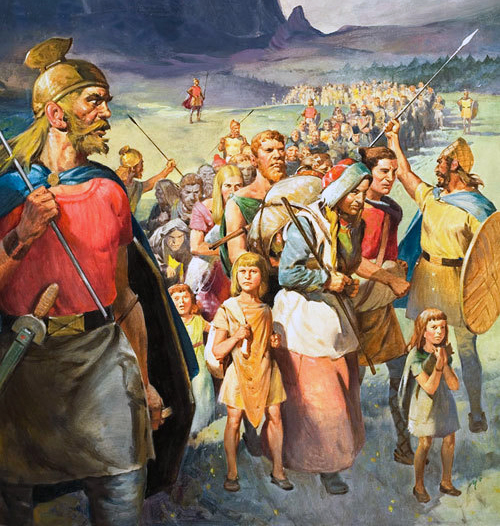 The Goths—Gutans or Gut-þiuda in their language—were the main people of the East Germans. Coming from Sweden, Gotland, Östergötland or Västergötland, they settled on the lower Vistula in the ‘transition period’, about the year 150 on the Black Sea. In the middle of the 1st century they split into Eastern and Western Goths (Ostrogoths, of austro, ‘bright’, and Visigoths, from wisi, ‘Good’), although they continued to be considered as a single people and usually called themselves only Goths. The Ostrogoths settled between the Don and the Dnieper (in present-day Ukraine), and the Visigoths between it and the Danube, from where they spread to the Balkans and Asia Minor, historians citing here generally the year 264. Dacia and Moesia (approximately the current Romania, Bulgaria and Serbia) were constantly under their pressure. In the year 269 Emperor Claudius II defeated them, Constantine often fought against them, and in 375 both towns (except the Catholic Crimean Goths, who remained there until the sixteenth century) were expelled by the Huns, who were advancing towards West. This tribe of nomads from the interior of Asia, were defeated and expelled in turn by the Chinese and only lived on horseback—’animals of two legs’ as Ammianus wrote—, advancing irresistibly from the northern shore of the Caspian Sea, extending the Russian plain and conquering a gigantic empire. Around 360 they had crossed the Don and reached Hungary by 430. However, allied with the Visigoths, the imperial general Flavius Aetius—who had sought and found protection among the Huns in the past—, defeated them in 451 in Gaul, in the Battle of the Catalaunian Plains. A few years later their king died, and more quickly than they had arrived, they largely withdrew towards Asia, in the Pontic steppes, the North Caucasus and the Sea of Azov. They were disbanded into several tribes and were henceforth known under the new name of Bulgarians.[1]
The Goths—Gutans or Gut-þiuda in their language—were the main people of the East Germans. Coming from Sweden, Gotland, Östergötland or Västergötland, they settled on the lower Vistula in the ‘transition period’, about the year 150 on the Black Sea. In the middle of the 1st century they split into Eastern and Western Goths (Ostrogoths, of austro, ‘bright’, and Visigoths, from wisi, ‘Good’), although they continued to be considered as a single people and usually called themselves only Goths. The Ostrogoths settled between the Don and the Dnieper (in present-day Ukraine), and the Visigoths between it and the Danube, from where they spread to the Balkans and Asia Minor, historians citing here generally the year 264. Dacia and Moesia (approximately the current Romania, Bulgaria and Serbia) were constantly under their pressure. In the year 269 Emperor Claudius II defeated them, Constantine often fought against them, and in 375 both towns (except the Catholic Crimean Goths, who remained there until the sixteenth century) were expelled by the Huns, who were advancing towards West. This tribe of nomads from the interior of Asia, were defeated and expelled in turn by the Chinese and only lived on horseback—’animals of two legs’ as Ammianus wrote—, advancing irresistibly from the northern shore of the Caspian Sea, extending the Russian plain and conquering a gigantic empire. Around 360 they had crossed the Don and reached Hungary by 430. However, allied with the Visigoths, the imperial general Flavius Aetius—who had sought and found protection among the Huns in the past—, defeated them in 451 in Gaul, in the Battle of the Catalaunian Plains. A few years later their king died, and more quickly than they had arrived, they largely withdrew towards Asia, in the Pontic steppes, the North Caucasus and the Sea of Azov. They were disbanded into several tribes and were henceforth known under the new name of Bulgarians.[1]
The Goths of the Balkans, the Lower Danube and the shores of the Black Sea were soon ‘converted’, the first among the Germans. This began in the 3rd century through contacts with the Romans and with captives. In the 4th century there was a notable increase of Christians among the Visigoths. In the year 325 the bishopric of Gomia already exists, under the orthodox bishop Theophilus; one of the participants in the Council of Nicaea. In 348 there is a persecution of Christians and in 369 a second one, which lasts three years. However, soon after most of the Visigoths are Christians. The Ostrogoths, on the other hand, if we give credence to Augustine, when penetrating Italy in 405 under King Radagaisus were still pagans; while in 488, when they invaded Italy with Theodoric, they were already Christians.[2]
The persecution of 348, led by a ‘judge of the Goths, without religion and profaner of God’, that is, a pagan, led to the expulsion of Ulfilas, the author of the Gothic Bible, consecrated around 341 by Eusebius of Nicomedia as ‘bishop of Christians in the land of the Goths’. With him a group of his followers fled, to whom Emperor Constantius II settled south of the Danube, in the province of the Lower Moesia, where their descendants lived for two centuries.[3]
The second persecution against the Christians under the Visigoths (in 369-372) was led by the prince Athanaric. It is perfectly understandable that already the ancient authors were fascinated with a man who, for example, refused to address Emperor Valens with the treatment of Basileus, arguing that he preferred the title of judge, which embodies wisdom, while the king only the power. The second persecution was not solely due to questions of faith. It was mainly an anti-Roman reaction and was closely related to the war between Goths and Romans between 367 and 369, although evidently also with the struggle for power between the princes Athanaric and Fritigern, the latter representing a policy favourable to the Romans and the Christians.[4]
After a meticulous preparation, Valens crossed the Danube in the year 367 and resumed a fight against the Goths that Constantine had already initiated, ending it in 332 by means of a formal treaty of peace with the Visigoths. Valens, without the warrior carving of the ‘great emperor’, ravaged the country, went hunting the heads of an enemy in disarray, but failed to reach the bulk of their opponents, as Athanaric always managed with great skill to flee to the Carpathians. And although in 369 he stopped with a part of his people and was defeated, it was so undecided that Valens had to accept his refusal to step on the Roman ground and had to spend a whole September day negotiating in a boat anchored in the river. Finally, the Gothic prince had free hands to dominate the adversaries in his own town, which led to three years of persecution.[5]
The reign of Athanaric did not tremble until the Huns overwhelmed the Ostrogoths and the Visigoths, at which time Athanaric and Fritigern, in spite of their enmity, fought side by side against the powerful invaders, and apparently the Ostrogothic king Ermanaric committed suicide in desperation. One part of his people were subjugated while the other crossed the Dnieper and fled towards the Visigoths. However, the defence sank before the hurricane of the Huns. With Athanaric they fled again to the impassable Carpathians. (In 1857 the workers who built a road there found, near a ruined fortress in Pietroasele, the Visigoth ‘treasure of the crown’. In a choker the following runic inscription appeared: utani othal ik im hailag: that is, a treasure of the Goths, I am invulnerable.) Defeated again, between forty and seventy thousand Visigoths fled to the south and asked in 376 Emperor Valens to admit them into the Roman Empire.[6]
While Athanaric left Gut-þiuda, the country of the Goths, and settled in the territories that would later be Transylvania, Valens authorised the immigration of the great mass of the Goths ruled by Fritigern as foederati; that is, colonists with the obligation to go to the army when they were needed: an ancient method of obtaining peasants, but above all soldiers. In the autumn of 376 they crossed the river, an event of great historical significance, probably by Durostorum (Silistra): a long row of chariots, often carrying the ancient pagan idols but also with some bishop among them, a Christian priest. And Fritigern, who with many of his own had become Arian in 369, promised Valens the ‘conversion’ of the part of his people that was still pagan, something that pleased the ears of the fanatical ‘heretic’, but that for the Goths was more a question of opportunism: misery and the Huns on the one hand and the attractive Roman Empire on the other. However, their exploiters and their officials, the monopolists of food and hunger caused that not a few Goths, even some bosses, sell as slaves their own wives and children, even in exchange for dog meat, a business quite common on the Danube. The thrust of the new ‘barbarians’, Visigoths, Taifals, Alans, and Huns on the open border pushed the newcomers, who occupied all of Thrace, to rebel and march on Constantinople, joining them bands of Huns, Alans and also slaves, peasants and workers of the mines of the country.[7]
_______________
Note of the translator: The footnotes still lack the general bibliography, which will be ready as I finish the abridgement of this first volume.
[1] Plin. nat hist 37, 35; 4.28. Tac. Germ. c 44. Socr. 6.34. Ammian 31.2.1 f; 31.3 f. Philostorg. 9.17. Stein, Vom römischen 289 f. Hauptmann 115 f. Schmidt, Ostgermanen 195, 201, 243. K.-D. Schmidt, Die Bekehrung 205 f, 215, 316 f. Capelle 185 f. Historically, Weibull (Die Auswanderung der Goten aus Schweden, 1958) is of special importance. Ferdinandy 186 f. Vemadsky 258 f. Dannenbauer, Entstehung 110 f, 193 f. Conrad, Deutsche Rechtsgeschichte 77. Maier, Die Verwandiung 109 f, 130. A. v. Müller, Geschichte unter useren Füssen 114 f. Rice 149. Schwartz, Goten 13 f, 142 f. Bullough, Italien 167. Wagner, getica 214. Claude, Westgoten 7. Stockmeier, Bemerkungen zur Christianisierung 316 f.
[2] Mansi Collect. Consil. II 214. Schmidt, Die Niedergang Roms 427 f. Aland, Glaubenwechsel 58 f. Stockmeier, Bemerkungen zur Christianisierung 315 f. Apparently, the first missionary of the Visigoths was one Eutyches, ibid.
[3] Jord. Get 267 (MG Auct., Ant. V 1,127). Lex dtv Antike, Religion H 311 f. Thompson, The Visigoths 94 f. Fridh, 130 f. Wolfram, Gotische Studien lis. Schäferdiek, Wulfila 107 f, especially 117.
[4] Ammian. 27.5.9. The sources in Jones, Prosography 120 f. Lex dtv Antike, Geschichte 1155. K. K. Klein Frithigem 34 f. Aland, Glaubenswechsel 59. Wolfram, Gotische Studien 2 f, 13. Handbuch der Kirchengeschichte II / l, 235.
[5] Ammian. 31,4,13. K. K. Klein Frithigem 38 f. Wolfram, Gotische Studien 4.9 f.
[6] Ammian. 31.3,4. Socr. e.h. 4.33 f. Soz. 6.37. According to Dudden 1165 they were ‘nearly a million persons of both sexes’. Giesecke, Die Ostgermanen 62 f. Schmidt, Die Bekehrung 223 f. Capelle 185 f. Thompson, Attila 23. Ensslin, Einbruch 101. Aland, Glaubenswechsel 60. Altheim, Hunnen I 351. Dannenbauer, Entstehung I 195. A. v. Müller, Geschichte unter unseren Füssen 115. Maier, Verwandiung 110.
[7] Eunap. fr. 42 f; 55. Ammian. 26, 10, 3; 27.4; 31.3 f. Zos. 4.10 f. Socr. e.h. 4.33 f. Soz. 6.37 f. Orog 7.32 f. Seeck, Untergang V 93 f, 101 f. Schwartz, Zur Geschichte des Athanasius 370. Delbrück, Kriegskunst II 280. Stein, Vom römischen 286 f. V. Campenhausen, Ambrosius 37 f. Schmidt, Die Bekehrung 242 f. The same, Die Ostgermanen 233. Giesecke, Die Ostgermanen 69 f. Capelle 172 f. Baetke, Die Aumahme17. Komemann, Weltgeschichte II, 352. The same, Römische Geschichte II 418 f. Ostrogorsky, Geschichte des byzantinischen Staates 43. Ensslin, Einbruch 100 f. Vogt, Der Niedergang Roms 310 f, 428. Dannenbauer, Entstehung 1195. Maier, Verwandiung 110. Claude, Westgoten 14 f, 26 f. Nehisen 161. Aland, Glaubenswechsel, 59 f. Wolfram, Gotische Studien 10.
Salvador Borrego
(1915-2018)
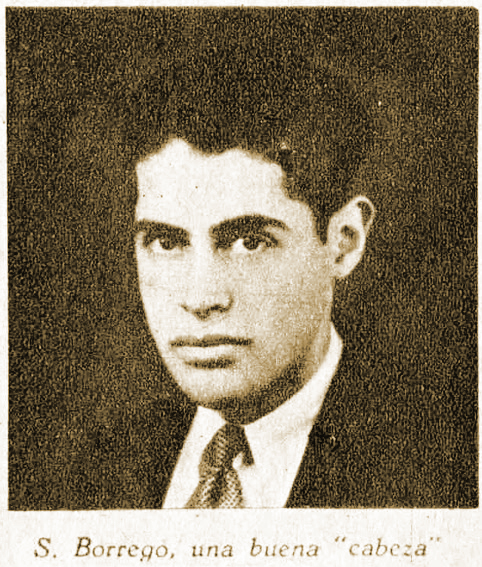
Mexican journalist Salvador Borrego, author of revisionist books about the Second World War, died last month, aged 102. The year that Borrego was a hundred years old, in 2015, David Duke paid a visit to him in Guadalajara, as can be seen in this photograph.
In 1955 the famous José Vasconcelos wrote a preface for Borrego’s main work, Derrota Mundial, in which Borrego argues that the world lost with the defeat of Germany.
Below, an abridged translation from the first volume of Karlheinz Deschner’s Kriminalgeschichte des Christentums (Criminal History of Christianity). For a comprehensive text that explains the absolute need to destroy Judeo-Christianity, see here. In a nutshell, any white person who worships the god of the Jews is, ultimately, ethnosuicidal.
The Ambrosian policy: archetype for the Church to the present
The same as Athanasius, Ambrose (in his post of 374-397)—according to Augustine’s testimony, ‘the best and most renowned bishop of Milan’—was not so much a theologian as a politician of the Church: equally inflexible and intolerant, although not so direct; more versed and ductile and acquainted with power since birth. His methods, more than those of Athanasius, remain to date an example for ecclesiastical politics.[1]
The agents of the saint are among the highest officials of the Empire. He acts skilfully from the background and prefers to let be that the ‘community’ does things, which he fanaticised with so much virtuosity that even the military proclamations directed against it fail.
Son of the prefect of Gaul, Ambrose was born about 333 or 339 in Trier. Orphaned at an early age he grew up, with two brothers, under the tutelage of Roman aristocrats. Having studied rhetoric and law he was appointed, around 370, administrator (consularis Liguriae et Aemiliae) in Milan. On December 7, 374 he would be consecrated bishop, barely eight days after his baptism and without even having the Christian knowledge of an educated layman.
Milan (Mediolanum), founded by the Gauls and a remarkable knot of communications, especially with important roads that lead to the alpine passes, was in the 4th century the capital of Italy and increasingly the imperial residence. Valentinian II sought to stay there as long as possible; Gratian still more, and Theodosius I remained there from 388 to 391, and also after his victory over Eugene (394).

Roman columns in front of basilica di San Lorenzo
in what remains of Mediolanum, the ancient Milan.
Sometimes Bishop Ambrose saw the sovereigns daily. Since when Valentinian II was proclaimed Augustus (375) he was barely five years old, his tutor and half-brother Gratian had just turned sixteen and the Spanish Theodosius was at least a very determined Catholic, the illustrious disciple of Jesus could handle perfectly their majesties. Valentinian I died a few years after Ambrose’s inauguration. His son Gratian (375-383), of just sixteen years of age, succeeded him on the throne.
The emperor, blond, beautiful and athletic had no interest in politics. ‘I have never learned what it means to govern and be governed’ (Eunapius). He was a passionate runner, javelin thrower, fighter, rider, but what he liked most was killing animals. Neglecting the affairs of state, every day he killed countless of them, with an almost ‘supernatural’ ability, even lions, with a single arrow. In any case, he also prayed every day and was ‘pious and clean of hearing’, as Ambrose affirmed so that he would soon deliver biting hints: ‘His virtues would have been complete had he also learned the art of politics’ (Epit. de Caesaribus).[2]
However, this art was practiced by Ambrose for him. Not only did he personally guide the young sovereign, effectively since 378: he also influenced his government measures. At that time the sovereign had promulgated, by an edict, precisely tolerance towards all confessions, except a few extremist sects. However, Ambrose, who four years before was still unbaptized, hastened to write a statement, De fide ad Gratianum Augustum, which he quickly understood.
And as soon as Gratian himself arrived at the end of July 379 in Milan, neutral as he was from the point of view of religious policy, he annulled on August 3, after an interview with Ambrose, the edict of tolerance promulgated the year before. He decided then that only would be considered ‘Catholic’ what his father and he in numerous decrees had ordered eternal, but that ‘all heresies’ should ‘be muted for eternity’. He thus prohibited the religious services of the other confessions. Year after year, except for 380, he issued anti-heretic decrees, ordering the confiscation of meeting places, houses and churches; he dictated exiles and, as a fairly new means of religious oppression, repealed the right to make wills. He was also the first of the Christian emperors who got rid of the title of Pontifex Maximus (that the Roman monarchs used since Augustus), or rather, he refused to accept it, although the year is still the subject of discussions. The military under Sapor was ordered to ‘expel from religious facilities the Arian blasphemy as if they were wild animals and return them to the true shepherds and flocks of God’ (Theodoret). Tolerance towards paganism, which was common among his predecessors, also soon disappeared. In fact, his father still allowed the reparation of damaged temples, making the government pay the expenses. In 381, Gratian moved to northern Italy. In 382 he attacked the pagan cult of Rome, most probably advised by Ambrose; although sanitation of the State coffers may also have played an important role. He also persecuted the Marcionists and, like his father, the Manichaeans and the Donatists: whose communities in Rome had been dissolved without further ado, at the request of Pope Siricius (383-399), with state aid.[3]
Valentinian II (375-392), much younger still, had a remarkable influence on the saint. He habitually used him against the Senate of Rome, mostly pagan, and against the entire Council of the Crown. And the last Westerner on the throne of the East, the independent Theodosius (379-395), dictated in almost every year of his government laws against pagans or ‘heretics’. However, according to Father Stratmann, he was more tolerant than the bishop of the court, who encouraged him to take stricter measures on all sides against the pagans, the ‘heretics’, the Jews, and the extreme enemies of the Empire. The reason: ‘It is no longer our old life that we continue to live but the life of Christ, the life of maximum innocence, the life of divine simplicity, the life of all virtues’ (Ambrose).[4]
The way in which Ambrose lived the life of Christ, the life of maximum innocence, of divine simplicity and of all the virtues, manifests itself in multiple ways—for example, in his behaviour against the Goths. We will deal with them because the Goths played a very important role in the history of Europe, especially between the 5th and 6th centuries. The sources are better in this case than in the other tribes of eastern Germans, and richer is the historiography on them.[5]
_______________
Note of the translator: The footnotes still lack the general bibliography, which will be ready as I finish the abridgement of this first volume.
[1] August. conf. 5,13.
[2] Eunap. Excerpt. de Sent. 48. Auson. Grat. Act 64 f. Ammian. 27,6,15; 31,10,18 f. Soz. 7,25,11. Vict. Epit. de Caesaribus 47,5 f. Seeck, Untergang V 165. Dudden I 217 f.
[3] Ammian 30,9,5. Theodor. e.h. 4.24.2 f; 5.2; 5.21.3 f. Socr. 5.2; Cod. Theod. 13,1,11; 16.5.4 f. Cod. Just. 1,5,2. Soz. 7,1,3. Ambros. ep. 1 f; 7 f. Auson. Grat. Act. 14.63. Epistula Gratiani imperat. (CSEL 79.3 f). Zos. 4,36,5. Rauschen 47.49 f. RAC II 1228 f. Kraft, Kirchenväter Lexikon 27. Seeck, Regesten 252. The same, Untergang V 104 f, 137. Sesan 60 f. Stein, Vom römischen 304 f. Heering I 60 f. Dudden I 191 f. V. Campenhausen, Ambrosius 15, 36, 40 f. Alföldi, A Festival. According to this author, Gratian abandoned the title of Pontifex Maximus at the beginning of 379, p. 36. Kornemann, Römische Geschichte II 420. Ensslin, Die Religionspolitik 8 f. Lorenz 38. Diesner, Kirche und Staat 23. Maier, Verwandlung 53. Hornus 168 f. Widmann 59. Grasmück 131 f, 151 f. Lippold, Theodosius 16, 34 f. Kupisch I 91. Schneider, Liebesgebot 46. Aland, Von Jesus bis Justinian 224. Heinzberger 12, 227 Notes 37; here the corresponding bibliography. Thraede 95. Grant, Christen 177. – Chronology, as so often happens, is still subject to controversy. G. Gottlieb, who is not followed here, in his work of opposition to chair in Heidelberg fixed for the writing of the first part of ‘de fide’ not the 378 (or 379), that is, not as was done until the date immediately before (or shortly after) the battle of Adrianople, but a year later. Cf. G. Gottlieb, Ambrosius von Mailand und Kaiser Gratian, Zusammenfassung 83 f. G. discusses even any influence of Ambrose on Gratian’s legislation on matters of the Church and faith, 51 f, or at least explains that such influence ‘cannot be seen anywhere’ (87). Cf. in this regard also Gottlieb, Gratianus RAC VII 718 f, especially 723 f.
[4] Ambros. Über die Flucht vor der Welt 44. Heilmann, Texte II 396. Stein, Vom römischen 296 F. Stratmann III 76. V. Campenhausen, Ambrosius 166. Bloch 197. Aland, Von Jesus bis Justinian 225. Rubin I 27 speaks precisely of the ‘submission’ of Theodosius to Ambrose.
[5] Cf. recently Strzelczyck 1 f.
Neochristian Ryckaert
The commenters on The Occidental Observer are once again talking about metaphysics, this time about a much healthier form of conceiving ‘god’, pantheism, than what the followers of the Abrahamic faiths do.
Franklin Ryckaert’s comment piqued my interest. It demonstrates that secularised racialists cling to Christian ethics:
- Unfortunately Pierce engaged in violent fantasies, not only in his two novels The Turner Diaries and Hunter, but also in his regular American Dissident Voices. I have listened to all his ADV and value most of their contents, but there is hardly any one of them in which he doesn’t fantasize about persons or groups “who should be hanged”. Such fantasies do not help our cause.
- The leadership of the National Alliance has now found its worthy successor in Kevin Alfred Strom, who is as gifted as Pierce and does not engage in violent fantasies.
Gifted as Pierce? You can imagine who will win the racial wars: the Jews and the Muslims who want to kill Aryans, or the white nationalists who still turn the other cheek…
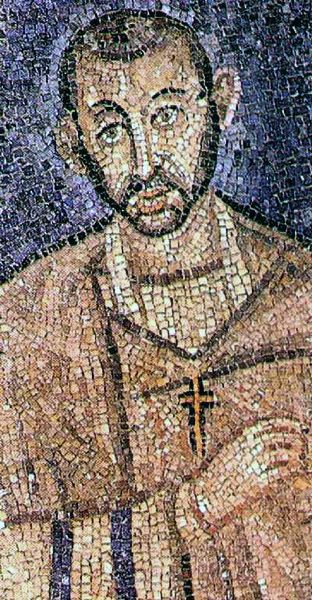
Editor’s note: Judging from how he treated the synagogues, we can infer that St. Ambrose was not ethnically Jewish. But he clearly was not white, as can be seen in this early mosaic.
Christianity arose in the lower strata, the mudbloods and sandniggers and in the Semitic regions of the Roman Empire. These were people who harboured a deep rancour towards the white Greco-Roman world.
In the chapter that Deschner dedicates to this very influential figure of the 4th century, we will see how this bishop committed all kinds of crimes: not only against classical culture but also the Aryan genotype itself (especially the Goths).
______ 卐 ______
Chapter 19: Ambrose, doctor of the Church
(toward 333 or 339 to 397)
‘An outstanding personality in which the virtue of the Roman with the spirit of Christ was united to give a complete unity: man, bishop and saint from the feet to the head; together with Theodosius the Great, the most important figure of his time, the counsellor of three emperors, the soul of their religious policy and the support of their thrones: a formidable champion of the Church’.
—Johannes Niederhuber, Catholic theologian [1]
‘Ambrose, the friend and counsellor of three emperors, was the first bishop to whom the princes came to support their tottering thrones… His extraordinary personality exuded an enormous influence, carried by the purest thought and a complete altruism… Together with Theodosius I, the most brilliant figure of his time’.
—Berthold Altaner, Catholic theologian [2]
‘Ambrose is a bishop who, in terms of the importance and scope of his activity, leaves in the shade all the others… not only surpasses the popes of the first period, but also all the other guides of the Western Church we know’.
—Kurt Aland, Protestant theologian [3]
_______________
Note of the translator: The footnotes still lack the general bibliography, which will be ready as I finish the abridgement of this first volume.
[1] Niederhuber LThK 1st ed. 350. Cf. also the “Allgemeine Einleitung” of Niederhuber in BKV 1914 IX f. Kraft also sees in Ambrose ‘Roman virtue completed and augmented with Christian virtue’. Kirchenväter Lexikon 23.
[2] Altaner 330 f.
[3] Aland, Von Jesus bin Justinian 230.
Mantra letter
Hello Mr. Tort,
Raised profoundly as a Catholic, today I am convinced that it is not enough to leave the religion of our parents. Liberation will need us to burn down worldwide all Christian churches to the ground. Such is my inspiration and mentality in the struggle for our survival.
—Albus
